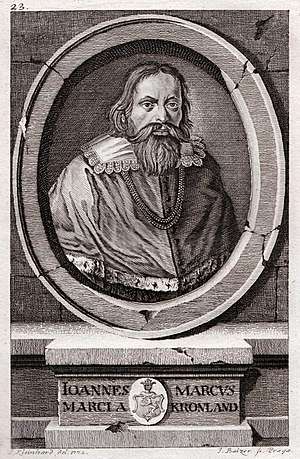Jan Marek Marci
Jan Marek Marci FRS, German: Johannes Marcus Marci de Cronland (June 13, 1595, Landskron (Lanscron, Landeskrone, Cronland, Kronland, Czech: Lanškroun), Royal Bohemia, Bohemian Crownland, Austria–April 10, 1667, Prague, R.Bohemia, Bohemian Crownland, Austria), or Johannes (Greek: Ioannes) Marcus Marci, was a Bohemian doctor and scientist, rector of the University of Prague, and official physician to the Holy Roman Emperors.[1] The crater Marci on the far side of the Moon is named after him.
Jan Marek Marci | |
|---|---|
 | |
| Born | 13 June 1595 |
| Died | 10 April 1667 (aged 71) |
| Nationality | Czech |
| Alma mater | University of Olomouc, Olomouc Charles University, Prague |
| Scientific career | |
| Fields | Medicine, Mechanics, Optics, Mathematics |
| Institutions | Charles University, Prague |
Career
Marci was born in Lanškroun, near the border between historical lands Bohemia and Moravia (presently parts of the Czech Republic). He studied under Athanasius Kircher,[1] and spent most of his career as a professor of Charles University in Prague, where he served eight times as Dean of the medical school and once as Rector in 1662. He was also the personal doctor of Emperors Ferdinand III and Leopold I, and distinguished himself in the defense of Prague against the Swedish armies in 1648. In October 1654 he was given the nobility title (falckrabě) "de Kronland" (anagram of "Landskron", German name for the city of Lanškroun). It is contested whether Marci was a member of the Royal Society. Some claim that he was elected as a corresponding member in 1667.[1] Other dispute this and argue that a Fellowship was not granted due to his death in this year.[2][3] Unlike in the legend spread by Jesuit order[4], he did not join the Jesuit order shortly before his death[5][6].
Work
Marci's studies covered the mechanics of colliding bodies, epilepsy, and the refraction of light, as well as other topics. Prior to Marci, the prevailing theory of color assumed that light was modified by the action of a medium to produce color. Most theories were based upon the assumption that color was simply a modification of light varying between whiteness and blackness. Marci preceded Isaac Newton in his belief that "Light is not changed into colors except by a certain refraction in a dense medium; and the diverse species of colors are the products of refraction."[7] Although he thought that different colors were caused by varying angles of incidence across the 1/2 degree apparent diameter of the sun, he stated that each color was condensed or disentangled from the others after refraction into homogeneous or elementary colors of red, green, blue and purple, and that no further change in color was obtained by additional refraction of elementary colors.[8]
Marci at some time came into possession of the Voynich Manuscript, apparently upon the death of its former owner, the alchemist Georg Baresch. He sent the book to his longtime friend Athanasius Kircher, with a cover letter dated 19 August 1666, or possibly 1665.[1] This cover letter has remained intact and was present when the manuscript was obtained by Wilfrid Voynich.
He is remembered today by the award of an annual medal to distinguished scientists by the Slovak-Czech Spectroscopy Society.
Books
- Operatricum Idea (1635)
- Idearum operaticum idea (1636)
- De proportione motus seu regula sphygmica (1639)
- Thaumantias. Liber de arcu coelesti deque colorum apparentium natura, ortu, et causis (Pragae: typis Academicis, 1648)
- Dissertatio de natura iridis (1650)
- De longitudine seu differentia inter duos meridianos (Praegae: Typis Georgij Schyparz, 1650)
- Labyrinthus, in quo via ad circuli quadraturam pluribus modis exhibetur (1654)
- Philosophia vetus restituta (1662)
- Othosophia seu philosophia impulsus universalis (1683)
A bibliography of Marci is provided by Heinrich Wilhelm Rotermund.[9]
References
- Tiltman, John H. (Summer 1967). "The Voynich Manuscript: "The Most Mysterious Manuscript in the World"" (PDF). XII (3). NSA Technical Journal. Archived from the original (PDF) on October 18, 2011. Retrieved October 30, 2011. Cite journal requires
|journal=(help) - Pagel, Walter; Rattansi, Pyarali (1964). "Harvey Meets the 'Hippocrates of Prague' (Johannes Marcus Marci of Kronland)". Medical History. 8 (1): 78, 81. doi:10.1017/S0025727300029112. ISSN 0025-7273.
- Gömöri, George (2015). Almási, Gábor (ed.). A divided Hungary in Europe: Exchanges, Networks and Representations, 1541-1699. Volume I (Study Tours and Intellectual-Religious Relationships). Newcastle upon Tyne: Cambridge Scholars Publishing. p. 154. ISBN 978-1-4438-9194-3.
- MacDonnell, Joseph. Companions of Jesuits: A History of Collaboration.Detroit: NU-AD Inc., 1995, p. 78.
- "494. schůzka: Muž z domu U zelené lípy". Dvojka (in Czech). 2004-12-12. Retrieved 2019-12-18.
- "Jan Marek Marci z Lanškrouna". vesmir.cz. Retrieved 2019-12-18.
- Richard S. Westfall, "The Development of Newton's Theory of Color" ISIS, Vol. 53, No. 3 (Sept. 1962) pp. 339-358
- Carl B. Boyer, The Rainbow from Myth to Mathematics (1959)
- Rotermund, Heinrich Wilhelm (1810). Fortsetzung und Ergänzungen zu Christian Gottlieb Jöchers allgemeinem Gelehrten-Lexicon, worin die Schriftsteller aller Stände nach ihren vornehmsten Lebensumständen und Schriften beschrieben werden, angefangen von Johann Christoph Adelung und vom Buchstaben K fortgesetzt von Heinrich Wilhelm Rotermund (in German). 3. Delmenhorst. pp. 902–903.
External links
- Galileo Project
- Voynich Manuscript Biographies
- (1635) Idearum operatricium idea - digital facsimile from Linda Hall Library
- (1648) Thaumantias - digital facsimile from Linda Hall Library